I have just returned home after an enjoyable European trip with my wife and daughter that included three days in London. We stayed at the Holiday Inn on Old Street in Shoreditch, in the Borough of Hackney. This is not an obvious location for tourists, most of whom visit the city to explore central London’s famous sites, but the hotel was perfectly located for exploring the increasingly popular areas around Brick Lane, including the famous market of Spitalfields. Brick Lane was within walking distance of the hotel (about a 20 minute walk), but we also had easy access to the rest of London through the bus stop opposite the hotel as well as the Old Street tube station (for underground trains), which was only a short 10-minute walk away. To make the most of our limited time we used the services of a local London guide who met us at the hotel on Sunday morning and took us on a three-hour guided tour. I have visited London many times in the past and have usually focused on London’s more famous landmarks, museums, galleries and bookshops. This time I wanted to visit a part of the city that I had not visited before and which I knew next to nothing about. Our tour started through the rear door of the hotel, which opened out onto an old cobble stoned square.
The square was surrounded by buildings dating from the nineteenth century that looked like they were originally used as warehouses of some sort, but now include accommodation for university students, a café and a school for training circus performers, which according to our guide provided many of the acrobats who entertained visitors at the 2012 Olympics. The school was located in a building that used to belong to an electric company – Shoreditch Electric Light Station – and dates from 1896. According to the school’s website, it is one of Europe’s top three schools for circus arts. The café in the square was aptly named The Juggler and, to continue the circus theme, a statue of a juggler by sculptor Simon Stringer stood on the pavement outside the café. The statue commemorates the theatre and music hall traditions from the local area of Shoreditch. The old square behind the hotel was almost deserted during our visit and seemed like a quiet place to get away from the fast paced bustle of Old Street. If we had had the time I’m sure it would have been very pleasant to have sat at one of the tables outside the café and nurse a coffee for an hour or so.
To continue the tour, we walked past the circus arts school and followed Coronet Street around a corner, then left on Hoxton Square, past the Electricity Showrooms and Rufus Street until the route reached Old Street, which we then crossed and continued along Curtain Road and then left on Rivington Street (if you want to follow the route, enter “Hoxton Square, London” in MapQuest). After a short walk we came across the back entrance to what looked like a pub or restaurant (which I later discovered was the Cargo nightclub). Through an iron gate, our guide pointed out artwork by Banksy, the British street artist and political activist. Also, next to the road there was artwork by French artist Thierry Noir, who is well known for his paintings on the Berlin Wall, dating from the mid-1980s. The painting was of one of Noir’s characteristic cartoon-like characters.
After viewing this artwork, we continued under the bridge on Rivington Street over which runs the East London Line (railway) until we reached Shoreditch High Street. We turned left, crossed the road and then followed Calvert Avenue past Saint Leonard church, known locally as Shoreditch Church. This church is famous for its associations with Shakespearean actors and the theatre of the Elizabethan age. For example, one of Shakespeare’s contemporaries, the actor James Burbage, who founded the first playhouse since Roman times in England – called The Theatre – in 1576, is buried in the church. James Burbage’s son, Richard Burbage, who acted in Shakespeare’s plays, died in 1619 and is also buried here. More recently, Shoreditch Church has been used as the backdrop for a comedy show on British television called “Rev.,” which I had not heard of, but is apparently popular with British television viewers. The show is about a country vicar who moves to the inner city and has to deal with all the challenges of a multicultural and multi-ethnic parish. The church dates from about 1740 and, as our guide mentioned, it features in the old nursery rhyme Oranges and Lemons by the phrase “When I grow rich, say the bells of Shoreditch.” After enjoying the church’s eighteenth century architecture, we continued along Calvert Avenue to Arnold Circus, part of a public housing development dating from the 1890s and opened by the Prince of Wales in 1900. Arnold Circus was built as part of the Boundary Estate to replace a slum area called Old Nichol.
The dominating feature of Arnold Circus was an elevated central green space, topped by a garden and bandstand, which was surrounded by a circular road and late Victorian housing. Steps led to the top of the garden from which there was a pleasant view of the surrounding area. This central garden space was constructed from rubble from the Old Nichol slum. Thinking about what this place used to be like, which one writer in the nineteenth century described as being “one painful and monotonous round of vice, filth, and poverty, [with people] huddled in dark cellars, ruined garrets, bare and blackened rooms, teeming with disease and death, and without the means, even if there were the inclination, for the most ordinary observations of decency or cleanliness,” (The Illustrated London News, 1863), it seemed amazing that I was walking around these streets with my family while on holiday! Indeed, the Old Nichol was regarded as being the absolute worst of the East End slums.
Arnold Circus was perhaps the world’s first social housing project and looked well preserved and clean. A regeneration project for the area was completed in 2010, which must have been of great benefit to the area. After continuing along Camlet Street, we spotted more street art. One small painting of a rhinoceros on the pavement next to Clifton House caught our attention. The painting possibly evokes the animal market that existed in the area until the early 1980s. We continued our walk along Chance Street, passing some more street art, including a large hedgehog by ROA, the Belgian street artist, and then we turned left onto Bethnal Green Road toward Brick Lane. We then crossed this road and took Sclater Street to view the stalls of the Sunday Market. There didn’t seem to be much worth buying as far as we were concerned and we continued along this street until we got to Brick Lane and then turned right.
Brick Lane is a long street that runs for about two miles north to south from a little east of Arnold Circus, near Swanfield Street, to Whitechapel High Street (notorious as the haunt of Jack the Ripper) by way of Osborn Street, which is basically a continuation of Brick Lane. The area consists of industrial buildings (such as those associated with Old Truman Brewery), religious buildings such as churches and the Jamme Masjid (mosque), rows of townhouses, markets of all kinds, cafes, restaurants (especially “curry houses”) and other stores. Most of the buildings existing today date from the eighteenth and nineteenth century. Brick Lane is famous for accommodating different groups of immigrants over the last few centuries, which is reflected in the great variety of businesses and cultural institutions in the area. The fact that the mosque mentioned above, at the corner of Fournier Street and Brick Lane, was originally built as a church and later became a synagogue before becoming a mosque illustrates the ethnic and cultural changes that have characterized the area over the years.
Immigrants from France (the Huguenots) lived in the area in the 1700s and early 1800s, and built some of the impressive townhouses in the surrounding streets, while in the later nineteenth century and early twentieth century it was a largely Jewish area with Yiddish being widely spoken (these were Jews who had immigrated mostly from Eastern Europe to escape persecution in the 1880s, although earlier Jewish immigrants came from other parts of Europe, including Amsterdam); but today it is a lot more ethnically diverse, including large numbers of people from Bangladesh and Somalia. Even some of the street signs are in both English and Bengali. The Museum of Immigration and Diversity is housed at 19 Princelet Street, close to the mosque, but it was not open during our tour. This museum is only open on restricted dates, but private tours can be arranged.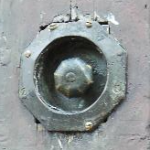
We then walked south along Brick Lane and stopped in a couple of markets. The first one was on the left after crossing Quaker Street. We walked through the doorway into what looked like an old warehouse and saw the traders setting up their food stalls. The food was being cooked on large pans over open flames. A myriad of food styles from different cultures were being cooked and I noticed food from Morocco, Vietnam and Malaysia to highlight just a few. I think we were all still full from breakfast and were not quite ready for eating more food, so we just admired the aromas and colors of the different ingredients that were being cooked, walked past the tables and then returned to the street to continue our journey down Brick Lane. A little further down the street, just before Woodseer Street, we turned left into another old warehouse to see a market full of stalls selling jewelry and other crafts, clothes, as well as more food. The items on sale looked to be of a high quality and with unique designs, but we were really more there to look than to buy and so after a 15 minute tour of what was on offer, we continued on down Brick Lane, past the Brick Lane mosque on the corner of Fourier Street, and Christ Church School; then we turned right on Fashion Street.
This street led toward the famous Spitalfields market. We walked past some old industrial buildings that now house the London campus of Glasgow Caledonian University and then continued to Great Eastern Street. We then turned right and walked past Christ Church Gardens and the eighteenth century church, which was built between 1714 and 1729 and was designed by Nicholas Hawksmoor, an English architect who had worked with Sir Christopher Wren; of St. Paul’s Cathedral fame.
Christ Church Spitalfields is regarded as being Hawksmoor’s masterpiece. It really was an impressive piece of architecture, with its tall spire towering over the other buildings in the area and four columns facing Great Eastern Street and the market. After admiring this great piece of architecture we continued to Spitalfields market, which occupies a huge covered space, and looked like it had recently undergone some modernization. The market was packed full of stalls with traders selling everything from food to art, fashionable clothes, jewelry, chocolate and many other things. We spent about 45 minutes just wandering around the stalls and admiring the architecture of the place. I purchased a beautiful print of a swimming goldfish by London-resident Malaysian artist, Keng Wai Lee. Some of his artwork can be viewed on his website. My wife and daughter also found some items in the market that they couldn’t do without! There were so many beautiful and high quality items at this market that I would have liked to have purchased but I wanted to stay focused on our tour and didn’t want to turn it into a shopping trip. We managed to pull ourselves away from the stalls and continue with our walk.
After leaving Spitalfields market, we crossed Great Eastern Street and walked down Fournier Street next to Christ Church. This street is flanked by old Huguenot houses that look unchanged since they were first built. Walking down this street really did feel like we had been transported back in time to the eighteenth century. It was remarkable how well preserved the houses looked. We walked back to Brick Lane and then turned right and walked down to Osborn Street. By this time we were ready for some refreshment. There were several cafes along this part of the route and we eventually went into Café Arena for some coffee or whatever else took our fancy. At this point we had completed our tour of Brick Lane. From the café it was a short walk to Whitechapel High Street and the East Aldgate tube station, from which we could catch a train back to our hotel.
There was so much to see along Brick Lane and the nearby area around Spitalfields market that a three-hour tour was really only enough to scratch the surface. But it served as a good introduction to an area that I had not visited before and that I would love to explore further in the future. Our daughter particularly enjoyed spotting the street art so it definitely was a family friendly tour. Our guide was Peter Berthoud, who led the way and provided a helpful commentary through these East End streets. (Note: For more contemporary descriptions of the East End slums, see The Victorianist blog. For an entertaining “insider” account of the area around Spitalfields and the East End in general, see Alan Gilbey’s book East End Backpassages.)
Street Art Around Brick Lane:
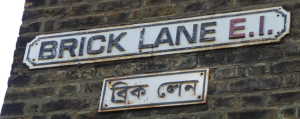

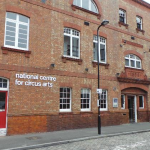
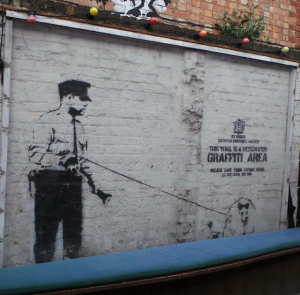
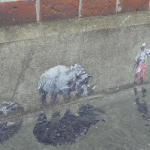
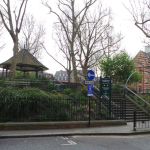
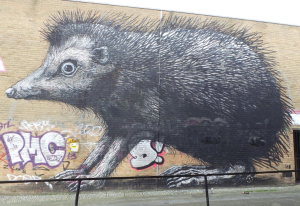

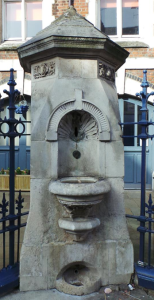

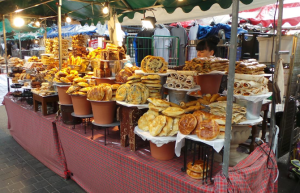


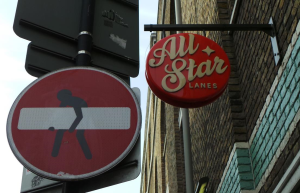
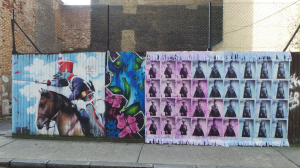
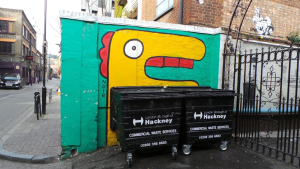
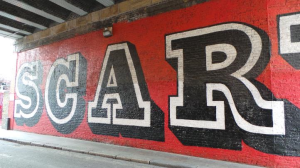
Hi,
For those interested in life around brick lane – specifically in the slums called ‘great eastern buildings’ – I have written a book based on 60’s life there. It can be found on a certain famous online shopping site beginning with ‘A’ It’s called ‘Great Eastern Buildings: chicanery, frolics and rat fishing’
For those visiting the area it can add extra thought and flare to tours and guides 🙂
Looks like a very interesting book. I love looking at old photos too. Thanks for posting!